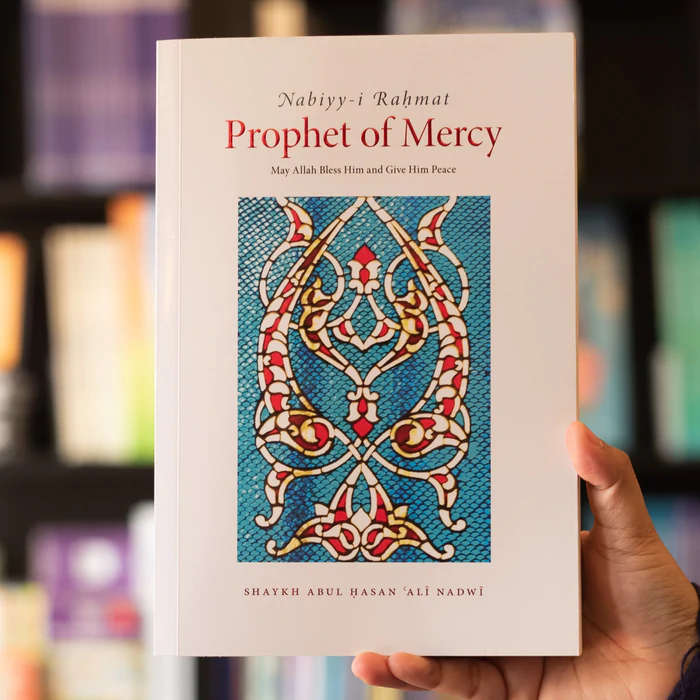Book Review
Book Name: Prophet Of Mercy
Author: Shaykh ʾAbul Ḥasan ʿAlī Nadwī
Translator: Dr. Mohiuddin Ahmad
Publisher: Turath Publishing
No. of pages: 432
Link to purchase: https://turath.co.uk/publications/prophet-of-mercy/
Over the centuries, books on the topic of Sīrah (Biography of the Prophet Muḥammad ﷺ) have been written in multitudes, different ones serving different purposes and drawing from different sources. “Prophet of Mercy” was written by a scholar revered by the East and West alike, Shaykh ʾAbul Ḥasan ʿAlī Nadwī رحمه الله (1999-1914) affectionally known as ʿAlī Miyan (a title of respect in Urdu) hailed from the descendants of the great Ṣaḥābī ʿAlī ibn ʾAbī Ṭalib رضی الله عنه. He was born in the city of Raibareli, India, and went on to become a great Islamic thinker, orator, and author, possessing a grasp on the different Islamic sciences.[1]
It was the environment the young ʾAbul Ḥasan was nourished in that shaped his understanding and embodying of the Sīrah. He was just nine years old when his father passed away, so his elder brother took care of his upbringing. Around this tender age, his brother gave him a Sīrah book titled Sīrah Khayr Al-Bashar with the aim of developing his character and to embed ʾīmān within him. At the age of ten or eleven, he came across the book Sīrah Raḥmah li al-ʿālamīn written by Qāḍī Manṣūrpūrī and came to greatly admire it.[2] The Sīrah had a lasting impact on the young boy’s life, shaping him to become the Shaykh ʾAbul Ḥasan ʿAlī Nadwī whom we know of today.
Prophet of Mercy is a translation of an Arabic book titled Al-Sīrah Al-Nabawiyyah, but the title comes from an Urdu translation of the book called Nabiyye Raḥmat. Prophet of Mercy was written at a time when the fear of physical colonisation was over in most Muslim lands but the spreading of certain Western ideologies and the subsequent loss of ʾīmān was the feared influence on Muslims, something which the author expressed.[3] This book was written with careful consideration of the current environment such that any doubts or questions in the contemporaneous mind could be answered along with the impact of softening the hardened modern heart so that the love of Muḥammad ﷺ could enter it. To carry out such a task, the author took from both classical and modern sources.
For around sixty pages at the beginning of the book, the author sets the scene around which the Prophet Muḥammad ﷺ was sent down. He talks about the spiritual darkness that had engulfed the world, the situation in Arabia, the situation in Makkah prior to the birth of Muḥammad ﷺ, and why Muḥammad ﷺ was sent down to the Arabs. The author builds a good image in the reader’s mind of the situation globally and locally in Arabia, elucidating how it was a miracle for Muḥammad ﷺ to have made the impact he ﷺ made at a time when the world was absorbed in extreme depths of misguidance. The author also sets the scene for Al-Madīnah Al-Munawwarah, describing its differences from Al-Makkah Al-Mukarramah, the variation in challenges the Prophet ﷺ would face here, and the conditions and nature of its peoples.
The author has a very impactful way of narrating the Sīrah by painting a clear picture of the events with his vivid explanations and great storytelling technique, as well as providing dates, locations (at times with maps which are a great asset in understanding the Sīrah), the background of events followed by the effect of said events, and the wisdom behind the choices of the Prophet ﷺ. As the story goes on the reader gets a real taste of who Muḥammad ﷺ was in terms of his ﷺ blessed character and personality, all of which invigorate a love for him ﷺ within the reader’s heart. The author whilst narrating the Sīrah recounts stories of the Ṣaḥabah رضي الله عنهم such as how they came to accept Islam, the sacrifices they endured, and the attributes that made them special, all as a means of inspiration for the reader.
After narrating the passing of The Prophet ﷺ, the author has chapters on the noble spouses and children of the Prophetﷺ, and the esteemed qualities of the Prophet ﷺ. The final chapter of this translation is titled “Mercy of the World” and is taken from a sermon delivered by the author in which he spoke about how Muḥammad ﷺ elevated humanity from the depths of darkness to light.
Overall, it is a comprehensive biography of the Prophet Muḥammad ﷺ for those who may or may not have previously read a book on the Sīrah. The translator and editors have ensured the translation reads well in English making the book a suitable read for anyone who has a flavour for reading. It is a book that is greatly acclaimed and one that became part of university syllabi, owing to its comprehensiveness and distinction. For those wishing to delve into the Sīrah, it is a book I would recommend.
Ml Abdullah Nakhuda
Ramaḍān 1443 h./April 2022
[1] M.A. Nadwi, Shaykh Abu Al-Hasan Ali Nadwi His life & works, (2nd edn, Batley: Nadwi Foundation, 2013).
[2] A.H.A. Nadwi, Al-ṭarīq ʾila al-madīnah, (4th edn, Beirut: Dār Al-Qalam, 1980), 11-13.
[3] A.H.A. Nadwi, ii: Maqālāt ʾIslāmiyyah fi al-fikr wa al-daʿwah, (Beirut: Dār ʾIbn Kathīr, 2004), 221-222.
Picture credit: https://wardahbooks.com/products/prophetofmercynabiyyirahmat


Leave a Reply